2022-2023 学年湖北省武汉市武昌区高三上学期第一次月考
英语试题及答案
本试卷共 150 分,考试用时 120 分钟。
注意事项:
1.答题前,考生务必将自己的学校、班级、姓名、准考证号填写在答题卡指定位置,认真
核对与准考证号条形码上的信息是否一致,并将准考证号条形码粘贴在答题卡上的指定位
置。
2.选择题的作答:选出答案后,用 2B 铅笔把答题卡上对应题目的答案标号涂黑,如需改动,
用橡皮擦干净后,再选涂其他答案标号。答在试题卷上无效。
3.非选择题的作答:用黑色墨水的签字笔直接答在答题卡上的每题所对应的答题区域内。
答在试题卷上或答题卡指定区域外无效。
4.考试结束,监考人员将答题卡收回,考生自己保管好试题卷,评讲时带来。
第一部分 听力(共两节,满分 30 分)
做题时,先将答案标在试卷上。录音内容结束后,你将有两分钟的时间将试卷上的答案转
涂到答题卡上。
第一节(共 5 小题;每小题 1.5 分,满分 7.5 分)
听下面 5 段对话,每段对话后有一个小题,从题中所给的 A、B、C 三个选项中选出最佳选
项。听完每段对话后,你都有 10 秒钟的时间来回答有关小题和阅读下一小题,每段对话仅
读一遍。
1. 【此处可播放相关音频】
Where are the speakers?
A. In a classroom.
B. In a bookstore.
C. At home.
【答案】A
【解析】
【原文】W: Michael, I lost my new pen. I just bought it from a bookstore on my way
home yesterday.
M: Oh, that’s too bad. But it’s time for class now. I can help you look for it
after class.
2. 【此处可播放相关音频】
�
What are the speakers mainly talking about?
A. The latest news.
B. The film reviews.
C. The magazine.
【答案】C
【解析】
【原文】M: I really like this magazine. It gives me all the recent news about movies.
W: I like it, too. But I prefer reading the film reviews in it.
3. 【此处可播放相关音频】
How long is the grocery store open every day?
A. 9 hours.
B. 10 hours.
C. 13 hours.
【答案】C
【解析】
【原文】W: Hello, this is Allen Grocery Store. Can I help you?
M: Hello. What are your opening hours, please?
W: We open at 9:00 a.m. and close at 10:00 p.m. every day.
4. 【此处可播放相关音频】
How does Barbara sound?
A. Content.
B. Worried.
C. Confused.
【答案】B
【解析】
【原文】M: Hey Barbara, why are you unhappy? I heard that you have been promoted.
Congratulations!
W: Oh, I hate having to leave here and working abroad. You know, my parents have
only one child. It is hard to imagine how lonely they would be if I work abroad.
5. 【此处可播放相关音频】
What is the probable relationship between the speakers?
A. Husband and wife.
B. Waiter and customer.
C. Shop assistant
and manager.
【答案】A
【解析】
【原文】W: I bought you a pair of pants, darling.
�
M: Oh, I hope you kept the receipt. I think I’ve put on some weight. But you can
taste the fish I cooked specially for you first. I’ll try the pants now.
第二节(共 15 小题;每小题 1.5 分,满分 22.5 分)
听下面 5 段对话或读白,每段对话或独白后有几个小题,从题中所给的 A、B、C 三个选项
中选出最佳选项.听每段对话或独白前.你将有时间阅读各个小题.每小题 5 秒钟,听完后,
各小题将给出 5 秒钟的作答时间。每段对话或独白读两遍。
听下面一段较长对话,回答以下小题。【此处可播放相关音频】
6. Why does the man want to sleep early today?
A. He has to catch an early flight tomorrow.
B. He feels sleepy while talking on the phone.
C. He has to collect a friend tomorrow morning.
7. When did the man probably come back?
A. At 9:15 p.m.
B. At 9:45 p.m.
C. At 10:15 p.m.
【答案】6. B
7. A
【解析】
【原文】M: Oh, I’m sorry, but I have to hang up now. I’m so sleepy.
W: It is only a quarter to ten.Why do you want to go to bed so early today?
M: I’m falling asleep on the phone.
W: Alright. Did you get up early this morning?
M: Yes. I took a friend to the airport. He had to catch the early flight.
W: Why didn’t you take a nap when you got home?
M: I didn’t get back until thirty minutes ago.
听下面一段较长对话,回答以下小题。【此处可播放相关音频】
8. What are the speakers mainly doing?
A. Talking about holiday plans.
B. Sharing childhood memories.
C. Discussing their last spring break.
9. Who went to the Grand Canyon with the girl?
�
A. Her mother.
B. Her father.
C. Her aunt.
10. What do we know about Robert?
A. He got married last year.
B. He has been to the Grand Canyon.
C. He was planning for a self-driving tour.
【答案】8. A
9. B
10. C
【解析】
【原文】W: We finally finished all the exams. Spring break starts tomorrow. Are you
going anywhere, Robert?
M: Yeah, I was thinking of driving to Arizona by myself.
W: To the Grand Canyon?
M: Yes. I’ve never been there.
W: I went there with my dad when I was a kid. I loved it very much. I still remember
how amazing it was.
M: That sounds nice. I’m sure I’ll like it, too. What are you planning to do this
holiday?
W: I’m going to visit my aunt in China with my mother. We haven’t seen her since
she got married last year.
听下面一段较长对话,回答以下小题。【此处可播放相关音频】
11. Why did Nina throw snow at Alex?
A. Alex knocked down her snowman.
B. Nina only wanted to play with snow.
C. Alex hoped to have a snowball fight.
12. What will Nina probably do next?
A. Go to the bathroom.
B. Take a good rest.
C. Apologize to
Alex.
13. What was Betty invited to do?
A. See a film.
B. Go to Nina’s home.
�
C. Pay a visit to Alex.
【答案】11. B
12. C
13. A
【解析】
【原文】M: Nina, why did you throw snow at your brother Alex?
W: Come on, Dad. I just had a snowball fight with him.
M: But he said that he didn’t know you were playing. Does this have anything to
do with the snowman?
W: Okay. You mean the one he knocked down? Hmm… no, I just wanted to have a snowball
fight.
M: Well, but you should be nicer to your brother. Go and say you’re sorry to him.
He is in the bedroom on the second floor.
W: Okay, I’ll do it now. After that I will go to Lily’s. She invited Betty and
me to watch a movie at her house.
听下面一段较长对话,回答以下小题。【此处可播放相关音频】
14. What is Conrad?
A. A scientist.
B. A teacher.
C. A student.
15. Who gave Conrad a compliment(表扬)?
A. Mrs. Hopkins.
B. Mr. Hunter.
C. Andrew.
16. What is the most important thing Conrad learned from the project?
A. A good sense of teamwork.
B. The skills in designing posters.
C. The abilities to survive outdoors.
【答案】14. C
15. B
16. A
【解析】
【原文】W: Hey Conrad.What final project did you work on?
M: Oh, I made an English poster about our environment.
W: It sounds pretty good. Was that an indoor or outdoor project?
M: Well, the project was carried out mostly outdoors, with only the last phase being
concluded indoors.
�
W: Is there anyone else involved in the project?
M: Yes.My teammates and an advisory teacher.
W: Who was your advisory teacher?
M: Our science teacher, Mrs. Hopkins. We learned a lot from her.
W: Good. Did you like your partners?
M: Yes. Most of them were friendly and responsible. And my favorite partner is Andrew,
the leader of my team.
W: Great. It was a successful project, right?
M: Yes, that’s right. We all received compliments from our professor, Mr. Hunter.
AnndI learned skills in writing contents and designing posters.
W: What else did you get from the project?
M: Above all, I knew how to work in a team and cooperate well with my teammates.
听下面一段独白,回答以下小题。【此处可播放相关音频】
17. Why did the teachers feel surprised?
A. They had no idea about the students’ interests.
B. Many students knew more about online games.
C. Their students were more interested in traditional games.
18. What can we learn from the talk?
A. Traditional games are still popular among many students.
B. Students today prefer to spend their breaks in the classroom.
C. Parents paid no attention to outdoor games when they were young.
19. What is still popular all over the world?
A. Hide-and-seek.
B. Shuttlecock (毽子) kicking.
C. Rope skipping.
20. What is educational officers’ attitude toward the situation of traditional
games?
A. Anxious.
B. Confident.
C. Unclear.
�
【答案】17. B
18. B
19. C
20. A
【解析】
【原文】M: During the years of game making, there have been a number of games. Many
old games have disappeared since modern games come out. Teachers at a primary school
asked their students to write articles about games they knew. And those teachers
were shocked by the results because more than half of the students wrote about online
games. It is easy to see that traditional games like hide-and-seek and jump rope
games are unfamiliar to many of today’s school children. An educationist said,
“Traditional games used to be so popular, but over just a few years, students have
forgotten them.” The games that many parents once played were generally outdoor
activities. They usually needed several partners and just a little space. Jump rope
games, for example, have always been popular around the world. A kind of jump rope
games played with rubber bands connected together to make a long rope played in many
countries. Rubber band jumping was once popular in primary schools. Girls loved
playing this game. This game can help kids practice their jumping skills, develop
coordination, and also meet lots of friends. It is common these days to see primary
school students spending their breaks in the classroom. They are busy with their
studies. “When we were young, we played many different outdoor games, but today’
s children don’t know what to play or how to play,” a 40-year-old mother said.
“If these kids want something, they can get it, but they don’t know what teamwork
is.” Alarmed by the situation, educational officers have tried to make some programs
to educate children about traditional games.
第二部分:阅读理解(共两节,满分 50 分)
第一节(共 15 小题;每小题 2.5 分,满分 37.5 分)
阅读下列短文,从每题所给的四个选项(A、B、C 和 D)中,选出最佳选项,并在答题卡上将
该项涂黑。
Water Power
A
Three Types of Renewable Energy Sources
Water power is the world’s biggest source of renewable energy by far, with China,
�
Brazil, Canada, the U. S. , and Russia the leading water power producers. While water
power is a clean energy source provided by rain and snow, it also has several
drawbacks.
Large dams can damage river ecosystems and surrounding communities, harming
wildlife and displacing residents. Even water power at full capacity bears its own
emissions problems, as rotting organic material in reservoirs releases methane (甲
烷,沼气).
Dams aren’t the only way to use water for power. Tidal and wave energy projects
around the world aim to capture the ocean’s natural rhythms. The potential marine
energy is great.
Wind Power
Wind turbines (涡轮) are growing around the globe, and China, the U. S., and
Germany are the leading wind energy producers.
Some people may object to how wind turbines look on the horizon (地平线) and
to how they sound, but wind energy, whose prices are declining, is proving too
valuable a resource to deny. Another problem with wind turbines is that they’re
a danger for birds and bats, killing hundreds of thousands annually that engineers
are working on solutions to make them safer for flying wildlife.
Solar Power
From home rooftops to farms, solar power is reshaping energy markets around the
world.
In addition to solar panels, which change the sun’s light to electricity,
concentrating solar power (CSP) plants use mirrors to concentrate the sun’s heat,
getting thermal energy. Solar thermal energy is also being used worldwide for hot
water, heating, and cooling. China, Japan, and the U. S. are leading the solar
transformation, but solar still has a long way to go.
21. Which country is the leading producer of all the three renewable energies?
A. China.
Russia.
B. Japan.
C. Germany.
D.
22. What may reduce the disadvantages of water power?
�
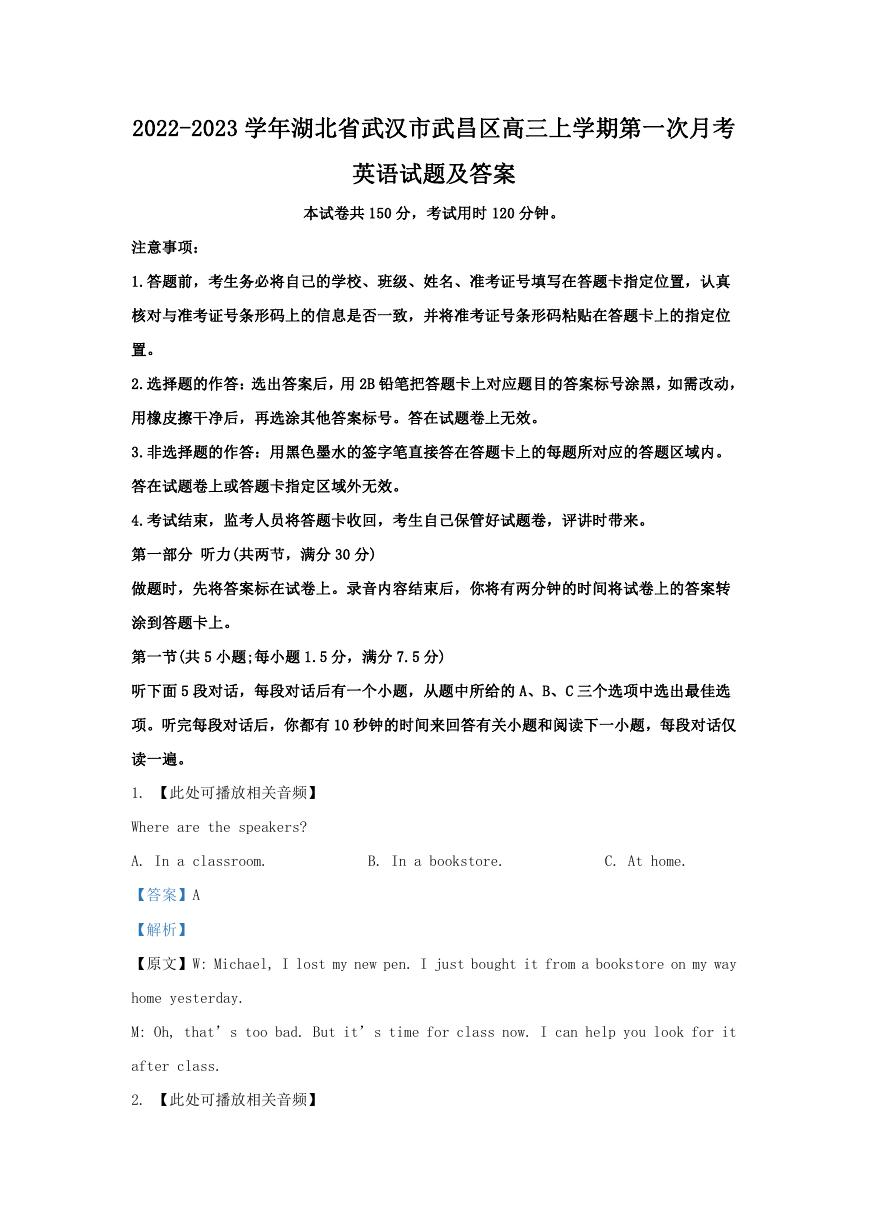
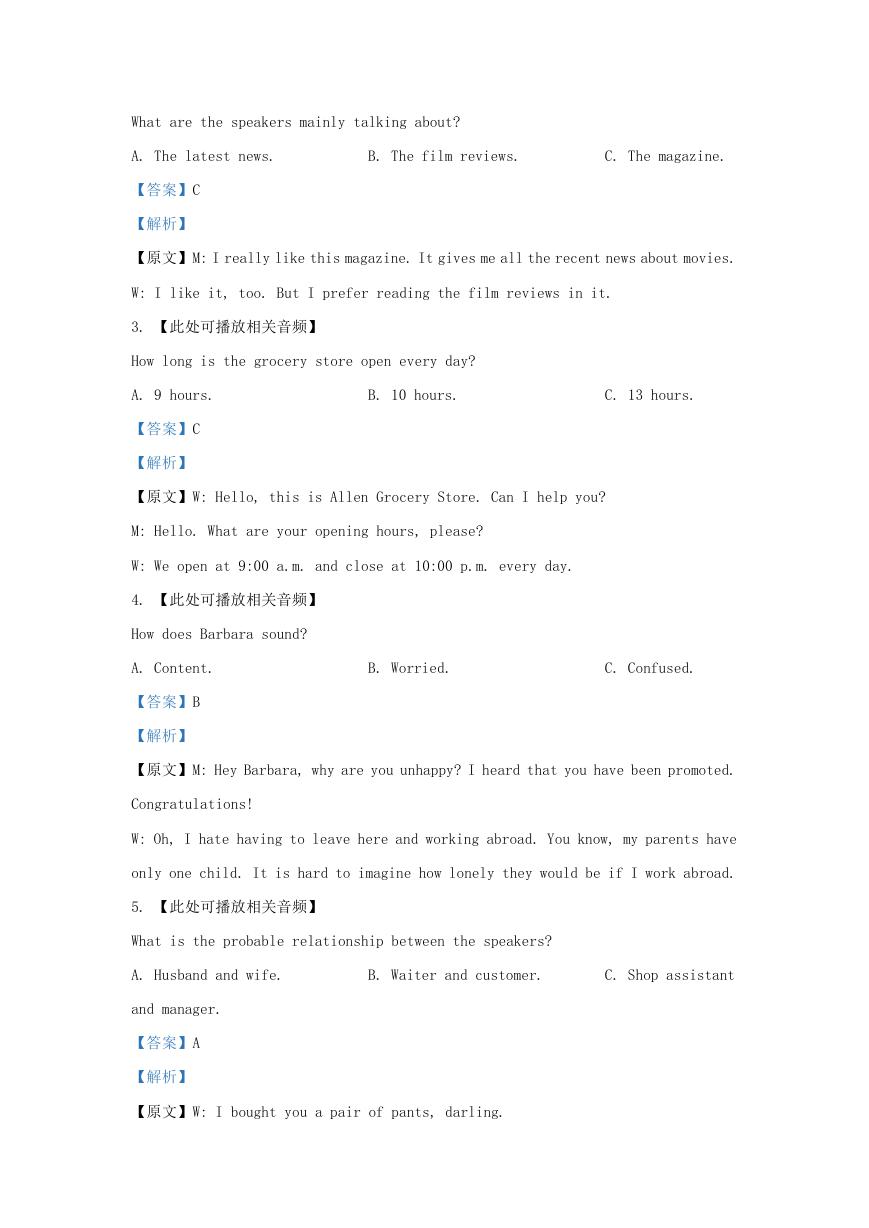
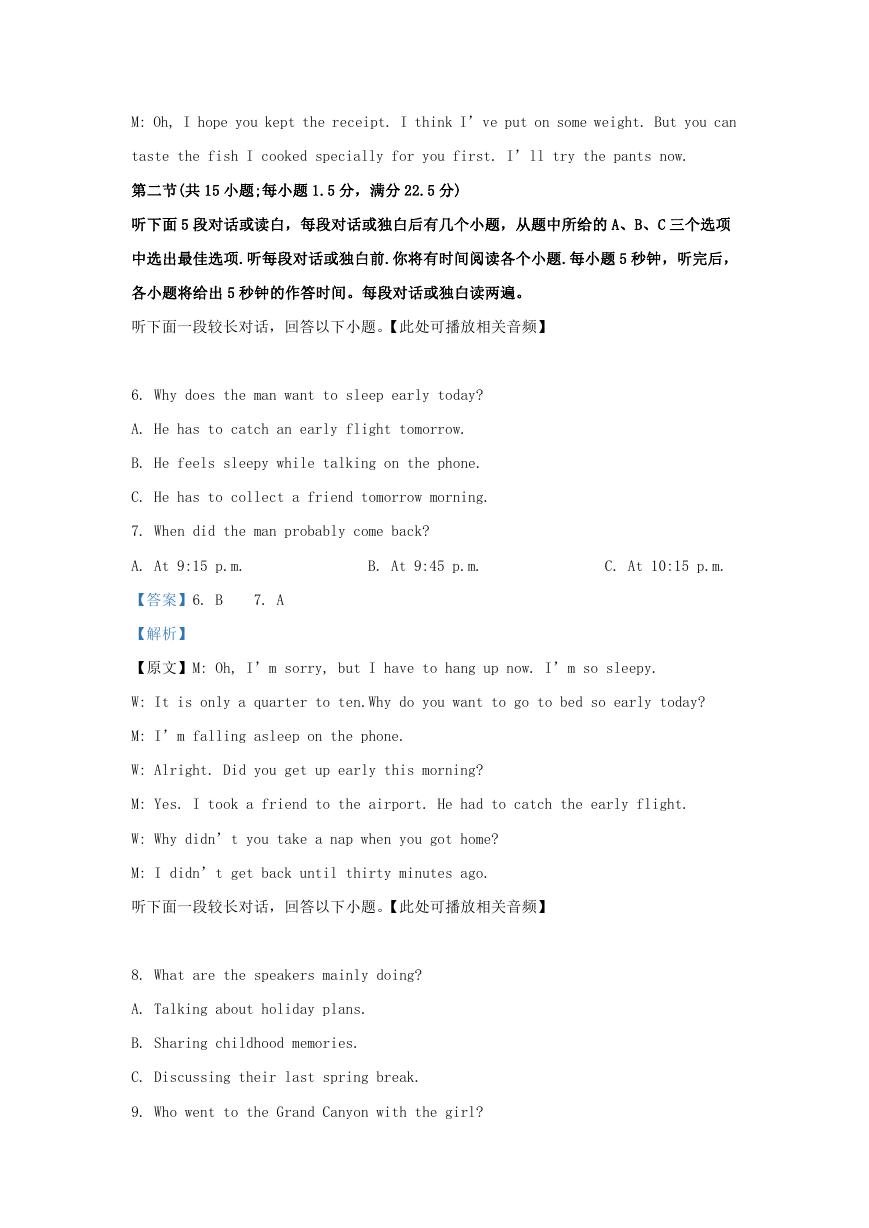

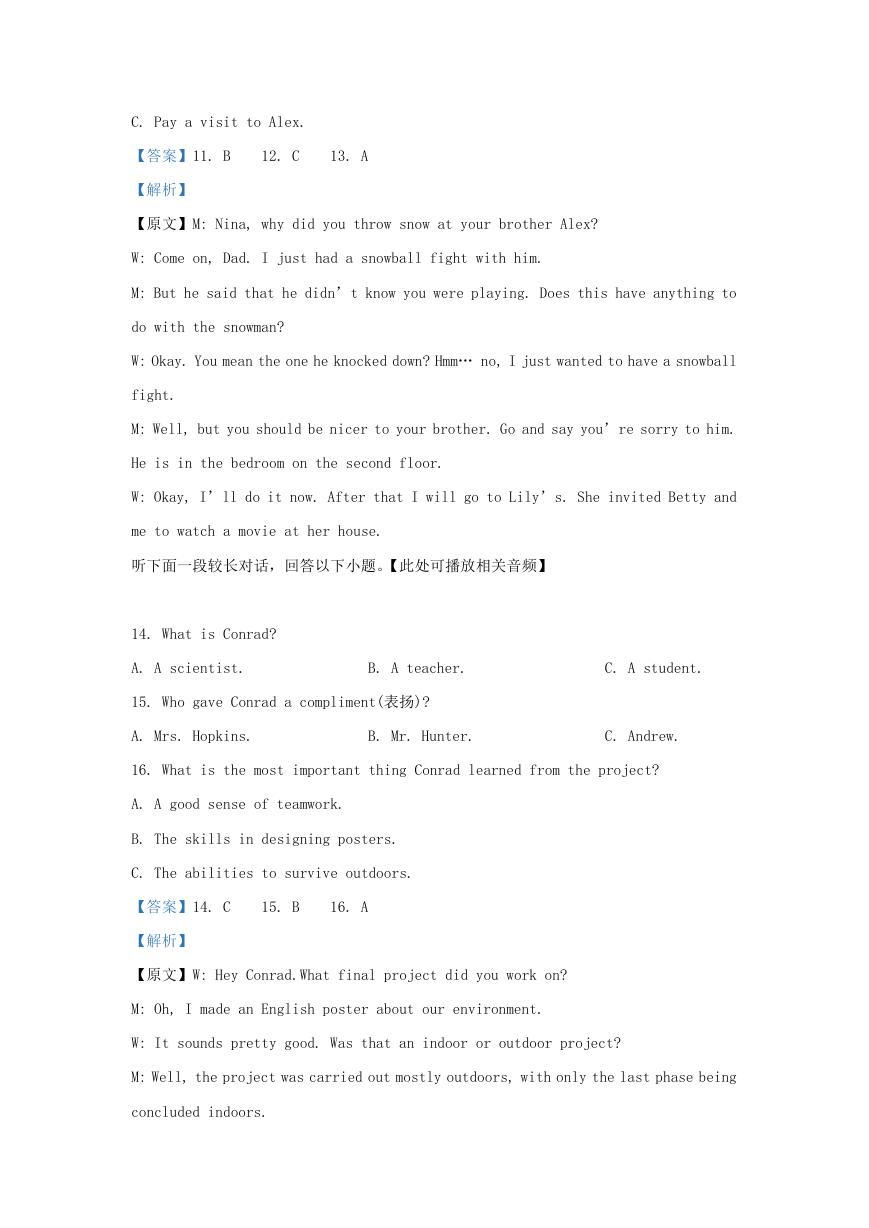
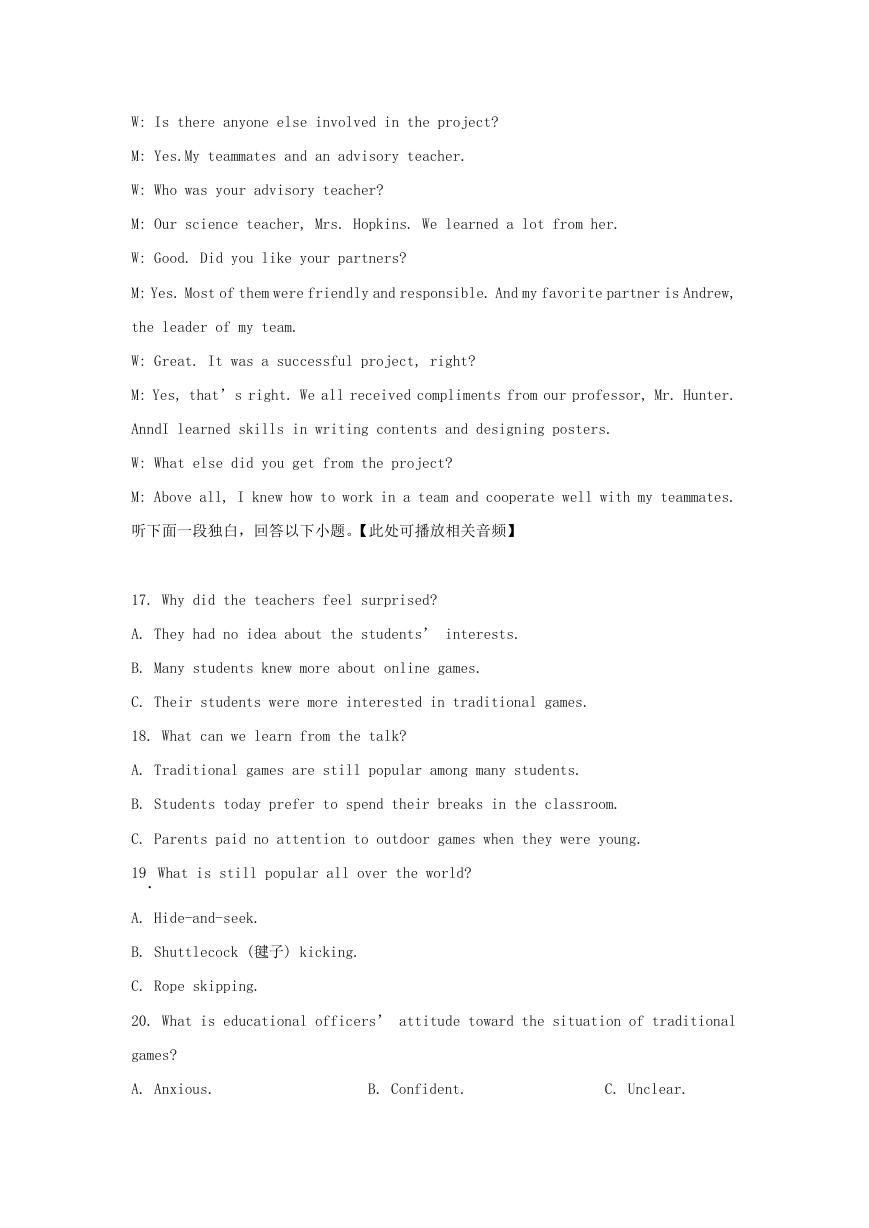
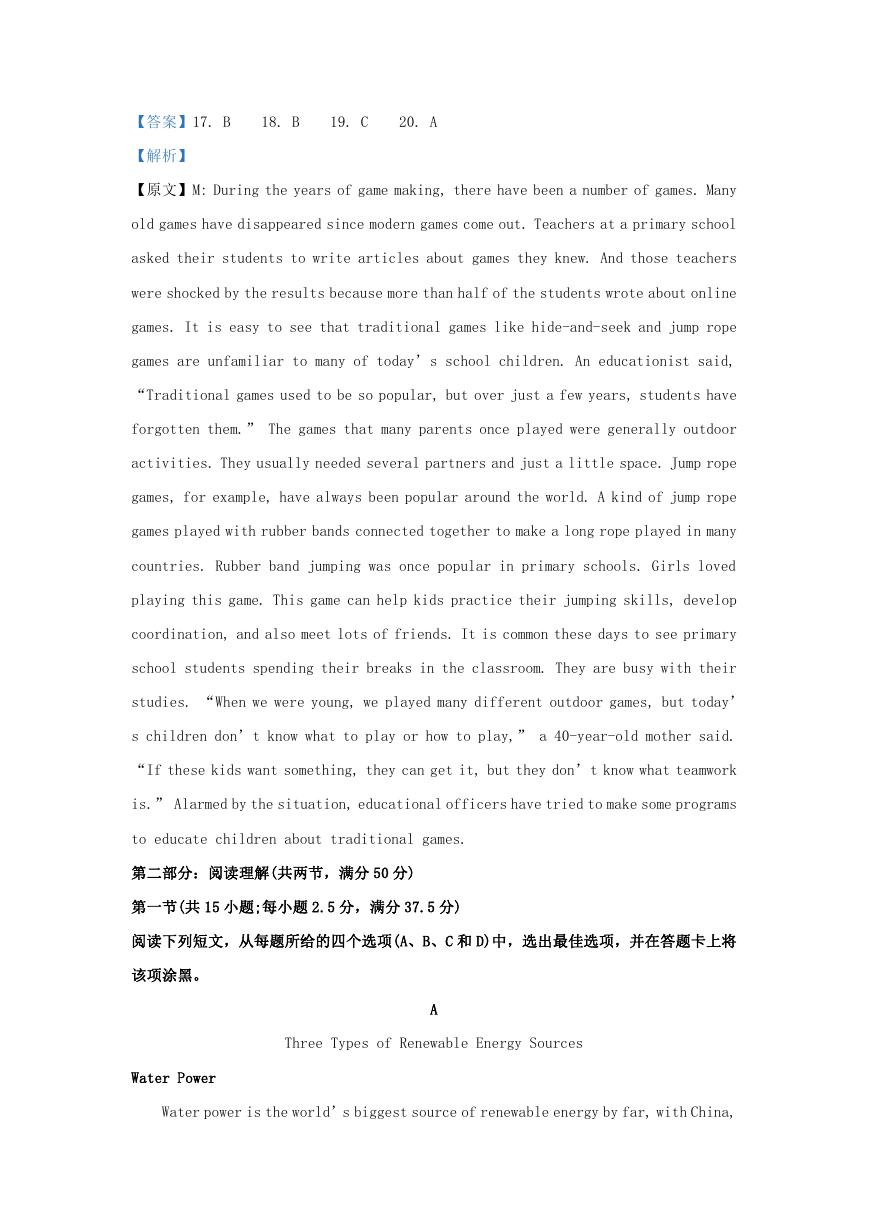









 2023年江西萍乡中考道德与法治真题及答案.doc
2023年江西萍乡中考道德与法治真题及答案.doc 2012年重庆南川中考生物真题及答案.doc
2012年重庆南川中考生物真题及答案.doc 2013年江西师范大学地理学综合及文艺理论基础考研真题.doc
2013年江西师范大学地理学综合及文艺理论基础考研真题.doc 2020年四川甘孜小升初语文真题及答案I卷.doc
2020年四川甘孜小升初语文真题及答案I卷.doc 2020年注册岩土工程师专业基础考试真题及答案.doc
2020年注册岩土工程师专业基础考试真题及答案.doc 2023-2024学年福建省厦门市九年级上学期数学月考试题及答案.doc
2023-2024学年福建省厦门市九年级上学期数学月考试题及答案.doc 2021-2022学年辽宁省沈阳市大东区九年级上学期语文期末试题及答案.doc
2021-2022学年辽宁省沈阳市大东区九年级上学期语文期末试题及答案.doc 2022-2023学年北京东城区初三第一学期物理期末试卷及答案.doc
2022-2023学年北京东城区初三第一学期物理期末试卷及答案.doc 2018上半年江西教师资格初中地理学科知识与教学能力真题及答案.doc
2018上半年江西教师资格初中地理学科知识与教学能力真题及答案.doc 2012年河北国家公务员申论考试真题及答案-省级.doc
2012年河北国家公务员申论考试真题及答案-省级.doc 2020-2021学年江苏省扬州市江都区邵樊片九年级上学期数学第一次质量检测试题及答案.doc
2020-2021学年江苏省扬州市江都区邵樊片九年级上学期数学第一次质量检测试题及答案.doc 2022下半年黑龙江教师资格证中学综合素质真题及答案.doc
2022下半年黑龙江教师资格证中学综合素质真题及答案.doc